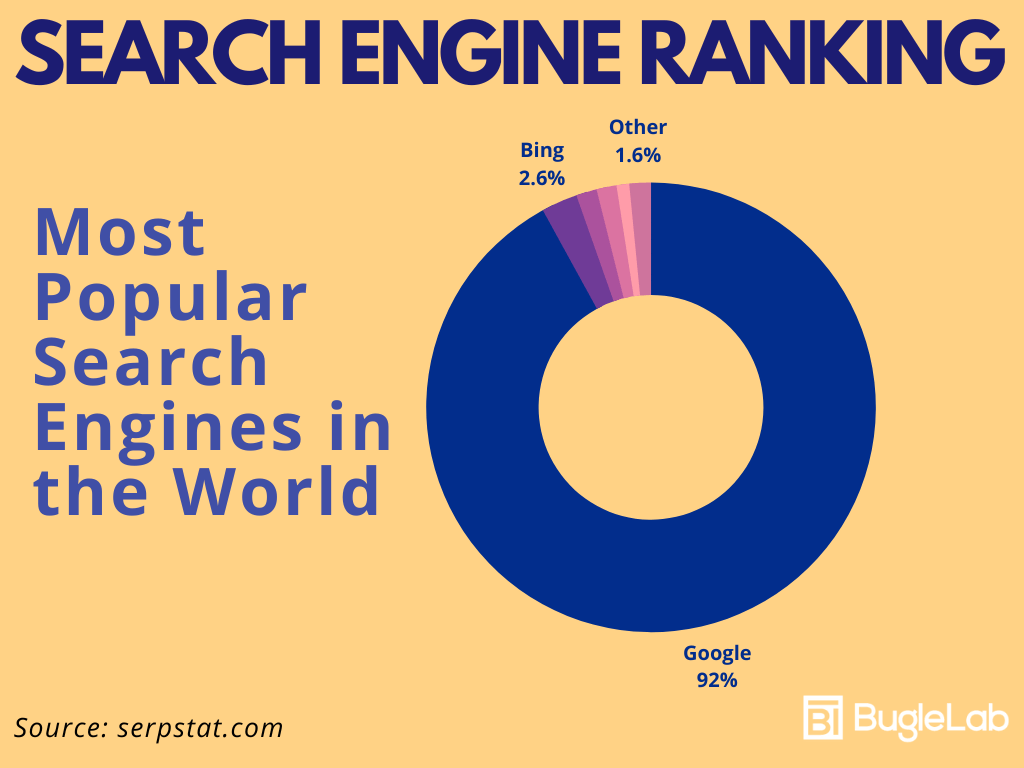Introduction
Cover image credit: frimbee
Does JAMstack Outperform WordPress in SEO?
Introduction
The primary objective of an SEO-friendly website is to enhance its visibility (ranking) on search engines. Websites that rank high on search engine results pages often benefit from free traffic, which has been shown to be more effective in generating revenue for businesses.
SEO is a crucial topic in the digital marketing sphere, and its significance cannot be overstated. It’s one of the most effective marketing strategies to invest in. When we talk about SEO, we usually mean Google SEO.

As illustrated in the chart above, Google dominates the search engine landscape. If you can optimize your website for Google SEO, your business is well on its way to receiving a steady flow of free monthly traffic.
Considering the intense competition and Google’s frequent search algorithm updates, SEO isn’t a one-time task anymore. For a website to rank higher in Google search results, its managers must excel in the following areas:
- On-page SEO: Optimizing your website’s content.
- Off-page SEO: Activities occurring outside your website.
- Local SEO: Optimizing a website for local searches.
- Technical SEO: Assisting search engine bots in crawling and indexing your website.
In this article, we’ll focus on Technical SEO and compare how Jamstack websites fare against WordPress (non-headless) sites in search engine rankings.
Is WordPress Really Poor in SEO?
In short, NO.
SEO doesn’t solely rely on the platform but on a collaborative effort to continually push, tweak, and optimize content to effectively address users’ search queries.
It would be unjust to dismiss WordPress from the SEO game, as technical SEO isn’t the only factor that contributes to search engine rankings. While Google’s latest search algorithm update prioritizes fast websites (technical SEO), WordPress websites can be fast too, like Techcrunch.
However, in terms of technical SEO, WordPress websites may have some disadvantages. Here’s why:
Speed: Google values speed. Although WordPress is fast, it doesn’t quite measure up to Jamstack websites, which are inherently fast due to their lack of backend database server burden, lightweight design, and impressive performance.
Security: Jamstack architecture doesn’t rely on databases, which eliminates security concerns. In contrast, WordPress heavily depends on databases that are vulnerable to exploits, making site security a significant issue. Site security is one of Google’s over 200 ranking factors.
Site Structure: Jamstack makes indexing a site for search engine crawlers easier, as the developer has full control over the website’s architecture and flow of all pages.
You can find some alternatives to WordPress
Emphasizing Speed in SEO
Assuming other ranking factors like on-page SEO are well-executed, a faster site load time can lead to better search engine rankings.
Jamstack websites, by their nature, favor pre-rendering over server-side rendering, and their ability to control site and content structure offers them an advantage in ranking higher.
What Makes Jamstack Great for SEO?
Site speed is a critical aspect of Technical SEO and a general site ranking factor.
Jamstack excels in speed; its serverless nature allows Jamstack websites to load incredibly fast.
But speed isn’t the only factor that makes Jamstack a strong choice for SEO. Other elements make Jamstack architecture an attractive option when building your website, such as structured site data.
Structured site data is a valuable SEO practice because Jamstack developers have full control over the site structure.
[JSON-LD]((https://moz.com/blog/json-ld-for-beginners) is a schema developed collaboratively by multiple search engines in 2011. It is used to clarify site elements and establish connections within a webpage, ultimately contributing to a more organized and improved web experience.
Incorporating JSON-LD into a static website is simple. You need to inject the required data directly into the HTML code, without having to create a separate schema for search bots and users.
Understanding Jamstack
Jamstack is a term used by web developers to describe a modern web design architecture. Its primary goal is not only to build web applications but also to enhance the web development process.
Learn more about Jamstack here.
By design, Jamstack websites load quickly, are easy to maintain, and are search engine friendly.
Jamstack and SEO Management
Jamstack architecture offers optimal optimization, making it well-suited for websites of all sizes to rank highly on search engine results pages.
Google prioritizes sites with quality content that can provide satisfactory answers to user queries. As a result, Google prefers websites with good content that can be delivered quickly and securely.
Jamstack embodies these principles by delivering fast static content with serverless backends and no databases (which can be entry points for attacks).
Rapid webpage rendering enhances user experience and subsequently reduces bounce rates. Additionally, Google bots can quickly index Jamstack sites as they are pre-rendered web pages with fewer moving parts.
Final Thoughts: The Future of Jamstack
Although most websites today are built on the highly monolithic and somewhat cumbersome WordPress open-source tool, an increasing number of developers are exploring Jamstack as a potential alternative.
As more individuals and businesses adopt serverless web architecture for personal and professional use, Jamstack is becoming a leading force in web development due to the intense competition in Search Engine Result Pages (SERPs).
Jamstack, by design, offers your website a competitive edge in achieving your SEO objectives.
Are you interested in learning how your business can benefit from substantial free monthly traffic with technical SEO fully covered on the SEO factor checklist? Talk to us now.
We won’t just build you a website positioned to rank higher; we’ll also provide long-term support, ensuring your site meets Google’s ever-changing SEO requirements in the technical department. In other words, we’ll be your long-term partner while you concentrate on other aspects of your business.






